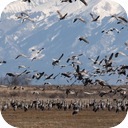(short preview of full seamless looping track)
Flock of Cranes
This product is not available in the selected currency.
In Stock
Backordered
Out of Stock
Description
The majestic family of feathered friends flies through the air, darting every which way, filling the sky and land with endless motion and an epic excitement of sound. It is difficult to know how many birds there are at one time, as they all seem to blend into a massive cloud that swims through the air like a school of fish and pecks at the ground like a heard of white buffalo, but the endless carpet of heads poking up to search for danger is truly a source of entertainment unlike any other. Cranes are a family, Gruidae, of large, long-legged and long-necked birds in the order Gruiformes. There are fifteen species of crane in four genera. Unlike the similar-looking but unrelated herons, cranes fly with necks outstretched, not pulled back. Cranes live on all continents except Antarctica and South America. Most species of cranes are at the least classified as threatened, if not critically endangered, within their range. The plight of the Whooping Cranes of North America inspired some of the first US legislation to protect endangered species. They are opportunistic feeders that change their diet according to the season and their own nutrient requirements. They eat a range of items from suitably sized small rodents, fish, amphibians, and insects, to grain, berries, and plants. Most have elaborate and noisy courting displays or "dances". While folklore often states that cranes mate for life, recent scientific research indicates that these birds do change mates over the course of their lifetimes (Hayes 2005), which may last several decades. Cranes construct platform nests in shallow water, and typically lay two eggs at a time. Both parents help to rear the young, which remain with them until the next breeding season. Some species and populations of cranes migrate over long distances; others do not migrate at all. Cranes are solitary during the breeding season, occurring in pairs, but during the non-breeding season they are gregarious, forming large flocks where their numbers are sufficient.
This sound uses the following file from Freesound: http://www.freesound.org/samplesViewSingle.php?id=115871
Opps
Sorry, it looks like some products are not available in selected quantity.



